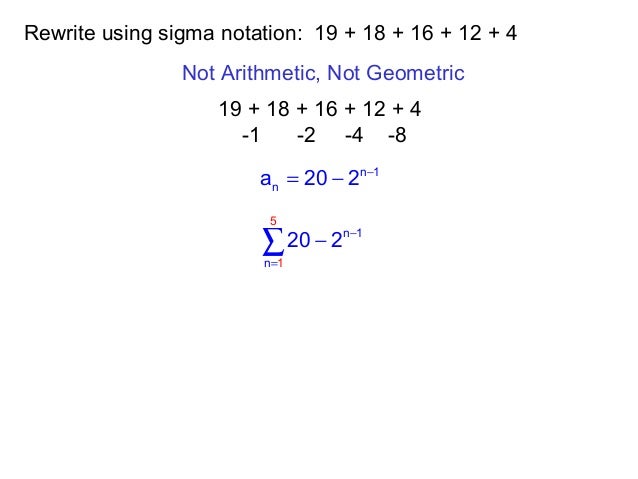
However, the intersection of infinitely many infinite arithmetic progressions might be a single number rather than itself being an infinite progression. Hence the use of the formula for an infinite sum of a geometric sequence S a 1 / (1 - r) 0.31 / (1. An online calculator to calculate the sum of the terms in an arithmetic sequence. In these sections students develop a formula to find the sum of geometric. Solve problems involving geometric sequences and the sums of geometric sequences.

ARITHMETIC AND GEOMETRIC SEQUENCES FORMULAS SUM SERIES
If each pair of progressions in a family of doubly infinite arithmetic progressions have a non-empty intersection, then there exists a number common to all of them that is, infinite arithmetic progressions form a Helly family. arithmetic sequence), geometric sequences lead us to geometric series as well. The intersection of any two doubly infinite arithmetic progressions is either empty or another arithmetic progression, which can be found using the Chinese remainder theorem. The formula is very similar to the standard deviation of a discrete uniform distribution. Where does the name of these two famous types of sequences come from The article Geometric progression of Wikipedia says that the geometric sequence is called like this because every term is the geometric mean of its two adjacent terms. Also notice that one can change arithmetic sequences to recursive formulas and vice versa. While a recursive formula does use itself to sequence back to its initial value, the result is still specifying the relationship between two variables.

If the initial term of an arithmetic progression is a 1 is the common difference between terms. I like to compare sequences to relations or functions we learned about in the Algebraic Functions section.Think of the (x)-part of the relation (the independent variable) as the numbers in a row that represent each part of the sequence these typically start at 1 (one). A function specifies a relationship between two variables. Finding the Number of Terms in a Geometric Sequence Finding the Sum of Geometric Series Instructional videos Interactive Quizmasters Related Lessons and. is an arithmetic progression with a common difference of 2. To add all the terms would be tedious, so we extract the information needed to use the formula to find the sum of the first n terms. In the next example we are given the sum in summation notation. For instance, the sequence 5, 7, 9, 11, 13, 15. Find the sum of the first 50 terms of the arithmetic sequence whose general term is an 4n + 3. The constant difference is called common difference of that arithmetic progression. An arithmetic progression or arithmetic sequence ( AP) is a sequence of numbers such that the difference from any succeeding term to its preceding term remains constant throughout the sequence.


 0 kommentar(er)
0 kommentar(er)
